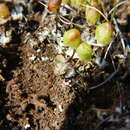Comprehensive Description
provided by North American Flora
Asterella saccata (Wahlenb.) Evans, Contr
U. S. Nat. Herb. 20: 276. 1920.
Marckantia fragrans Schleich. [PL Crypt. 'Bxsic.neivQt.S: 6^: hyponym. 1804:1; DC. Fl Fr 2* 423. 1805. Not M.fragrans Balbis, 1804.
Marchantia saccata Wahlenb. Ges. Nat. Freunde Berlin Mag. 5: 296. 1811.
Fimbriaria saccata Nees, Horae Phys. Berol. 45. 1820.
Fimbriaria fragrans Nees, Horae Phys. Berol. 45. 1820.
Hypenantron ciliatum Corda, in Opiz, Beitr. 648. 1829.
Marchantia umbonata Wallr. Linnaea 14: 686. 1840.
Fimbriaria umbonata Wallr.; G. I/. N. Syn. Hep. 559. 1846.
Asterella fragrans Trevisan, Rend. 1st. Lomb. II. 7: 785. 1874.
Hypenantron fragrans Trevisan, Mem. 1st. I/Omb. 13: 440. 1877.
Hypenantron umbonatum Trevisan, Mem. 1st. iomb. 13: 440. 1877.
Hypenantron saccatum Trevisan, Mem. 1st. Lomb. 13: 440. 1877.
Thallus green above in the middle but more or less pigmented with purple beneath and along the margin, mostly 0.5-1 cm. long and 2-3 mm. wide, with a rounded or bluntly angled keel and undulate margins, strongly incurved when dry, the branching dichotomous; epidermal cells averaging about 30 X 20 /x, the walls mox-e or less thickened and with distinct trigones; cell^ containing oil-bodies few and scattered; pores more or less elevated, sm-rounded by about 6 radiating series of cells with 2 or 3 cells in each series, the radial walls thin or with trigones; green tissue fairly loose, the dorsal air-chambers subdivided by supplementary partitions and apparently more numerous than the pores; compact ventral tissue composed of thinwalled cells without pits; appendages of ventral scales one or two, sometimes more or less connate, subulate, mostly 0.7-1 mm. long and 0.2-0.3 mm. wide, long-acuminate, the margin entire to sparingly and irregularly dentate or spinose -dentate, hyaline and forming a dense apical cluster. Paroicous or^utoicous; antheridia forming an elongate, median, dorsal cluster anterior to the female receptacle or on a separate branch; stalk of female receptacle with a dense basal cluster of hyaline, lanceolate scales, otherwise naked, more or less pigmented, about 2 cm. long; disc bluntly conic, about 3 mm. wide, covered with low tubercles, shortly 3or 4-lobed, the lobes extending almost vertically downward; involucre entire to sinuate; pseudoperianth white, mostly 8-cleft, the segments connate at their tips, lanceolate; operculum remaining intact at dehiscence; spores brownish-yellow, 80-90 ju in diameter, with wavy wings 10-12 fl wide; spore-surfaces covered over with a very fine and often regular reticulum, the meshes about 2 ju wide, formed by delicate lines, otherwise smooth or with occasional low folds or tubercles never forming a reticulum; elaters yellowish-brown, mostly 10-14 ju wide, sometimes unispiral throughout, sometimes bior trispiral in the middle.
Type locality: Kamchatka.
Distribution: Yukon, British Columbia, Idaho, and Washington; also in Europe and Asia.
- bibliographic citation
- Caroline Coventry Haynes, Marshall Avery Howe, Marshall Avery Howe, Alexander William Evans. 1923. SPHAEROCARPALES - MARCHANTIALES; SPHAEROCARPACEAE, RIELLACEAE; RICCIACEAE, CORSINIACEAE, TARGIONIACEAE, SAUTERIACEAE, REBOULIACEAE, MARCHANTIACEAE. North American flora. vol 14(1) New York Botanical Garden, New York, NY

